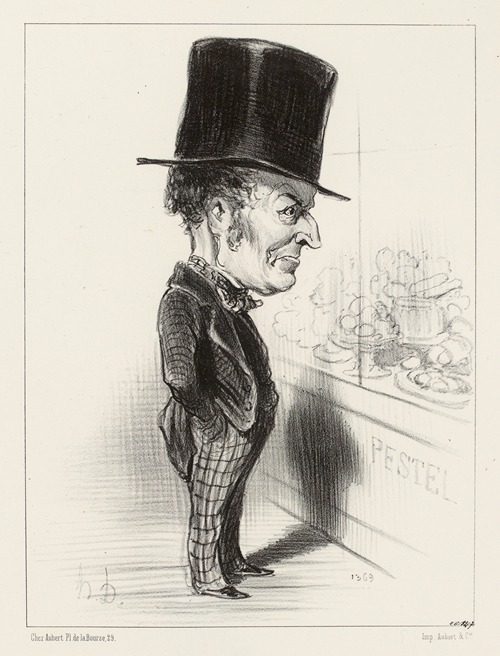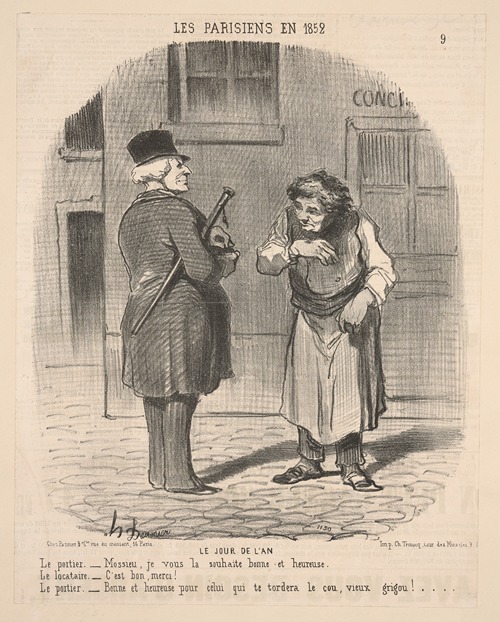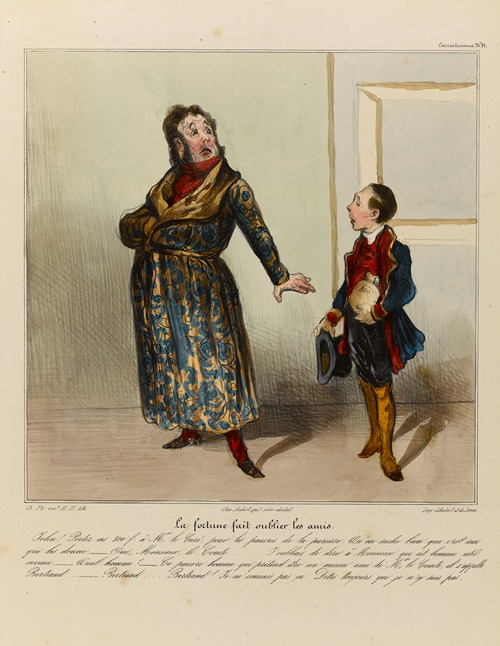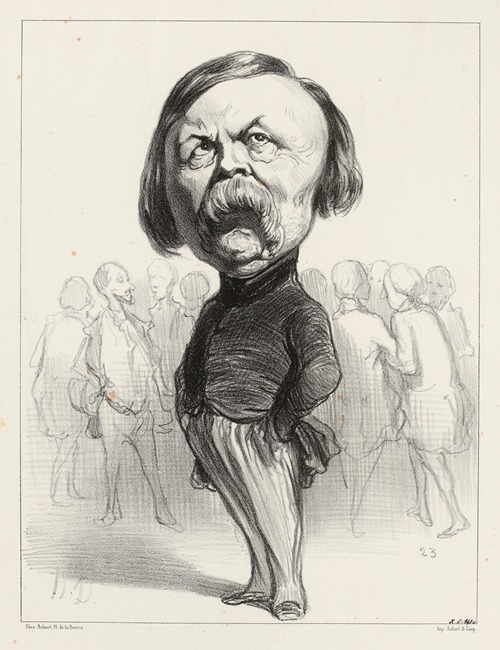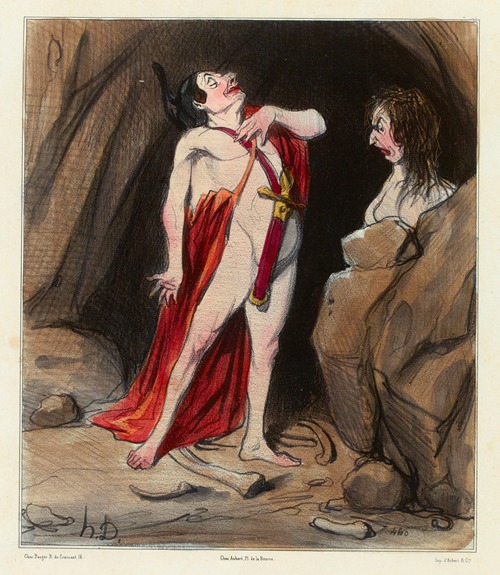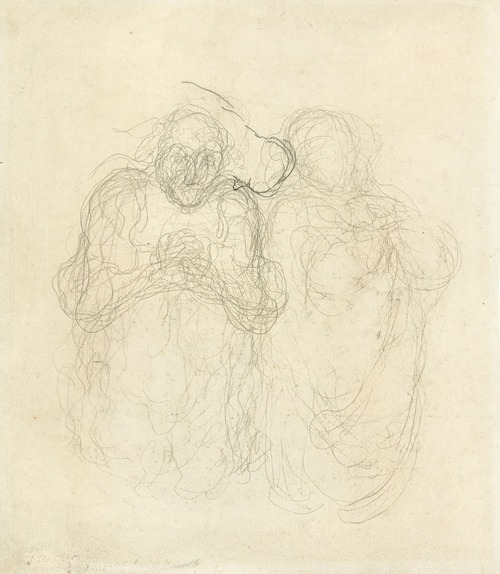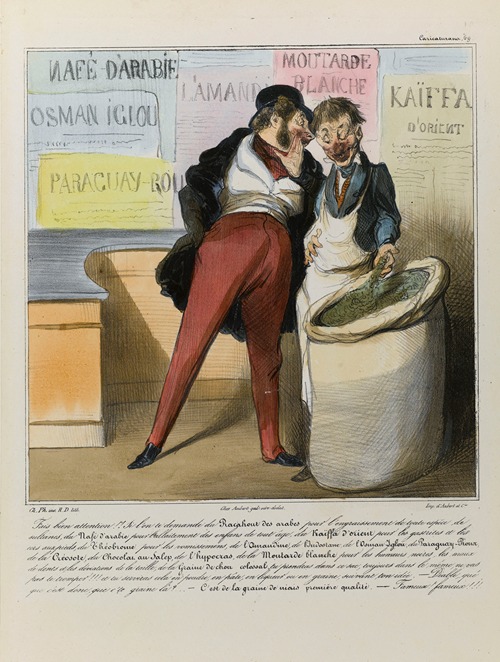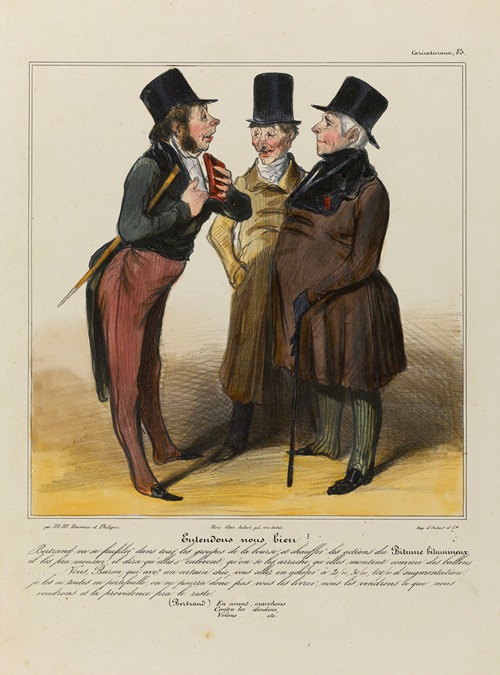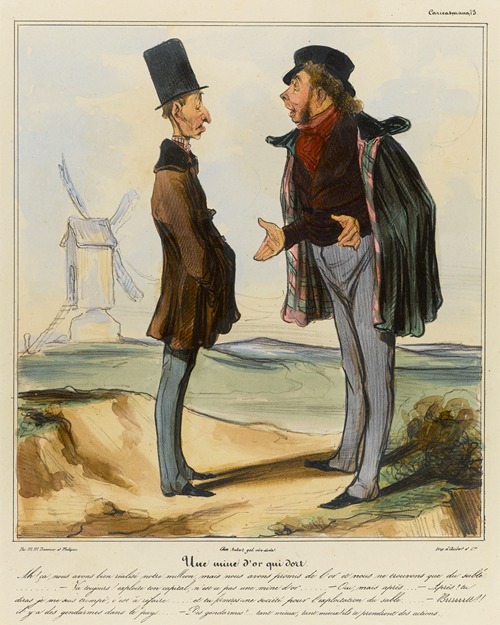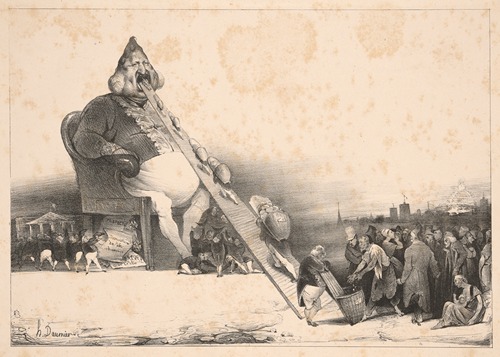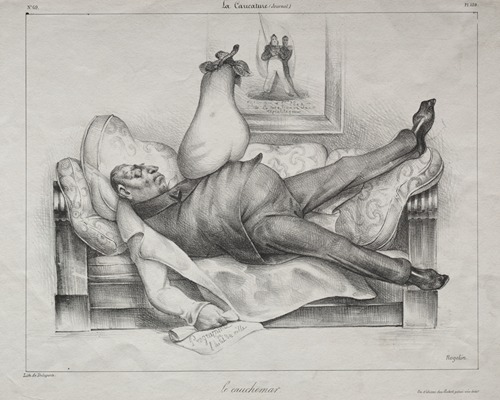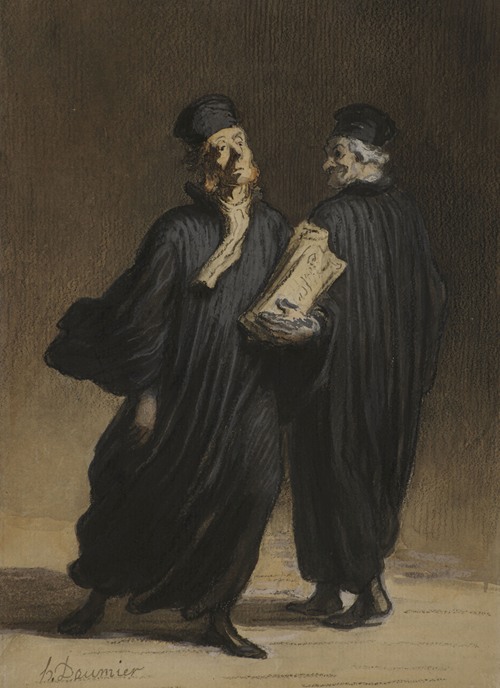
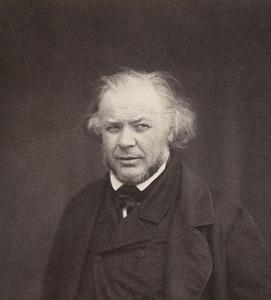
Honoré-Victorin Daumier was a French painter, sculptor, and printmaker, whose many works offer commentary on the social and political life in France, from the Revolution of 1830 to the fall of the second Napoleonic Empire in 1870. He earned a living throughout most of his life producing caricatures and cartoons of political figures and satirizing the behavior of his countrymen in newspapers and periodicals, for which he became well known in his lifetime and is still known today. He was a republican democrat who attacked the bourgeoisie, the church, lawyers and the judiciary, politicians, and the monarchy. He was jailed for several months in 1832 after the publication of Gargantua, a particularly offensive and discourteous depiction of King Louis-Philippe. Daumier was also a serious painter, loosely associated with realism.
Although he occasionally exhibited his paintings at the Parisian Salons, his work was largely overlooked and ignored by the French public and most of the critics of the day. Yet the poet and art critic, Charles Baudelaire and Daumier's fellow painters noticed and greatly admired his paintings, which were to have an influence on a younger generation of impressionist and postimpressionist painters. Later generations have come to recognize Daumier as one of the great French artists of the 19th century.
Daumier was a tireless and prolific artist and produced more than 100 sculptures, 500 paintings, 1000 drawings, 1000 wood engravings, and 4000 lithographs.
Daumier was born in the south of France, in Marseille, to Jean-Baptiste Louis Daumier and Cécile Catherine Philippe. His father Jean-Baptiste was a glazier (corresponding nowadays to a framer), a poet and a minor playwright whose literary aspirations led him to move to Paris in 1814, followed by his wife and the young Daumier in 1816. Although Daumier's father succeeded in publishing a book of verse and having an amateur troupe of actors perform his play in 1819, financial success was minimal and the family lived in poverty. At the approximant age of twelve (c. 1820–21), Daumier started to work. His father found him a job working as an errand boy for a huissier de justice. Later he found employment at Delaunay's, a well established bookstore at the Palais-Royal, a hub of Parisian life, where he began to meet artists, develop an interest in art, and started drawing. He spent much of his free time in the Louvre. In 1822 he became protégé to Alexandre Lenoir, a friend of Daumier's father and the founder of the Musée des Monuments Francais (now Musée national des Monuments Français), who trained Daumier in the fundamentals of art. The following year he entered the Académie Suisse where he was able to draw from live models and develop friendships with other students including Philippe Auguste Jeanron and Auguste Raffet.
Lithography was a relatively new form of printmaking in the early 19th century, invented in Germany in the late 1790s. It was a fast and cheep method of mass-producing prints compared to the traditional practices of engraving and etching. Likewise, the art of the caricature, which was relatively established and popular in England (e.g. William Hogarth, Thomas Rowlandson), was just coming into vogue in France about this time. Lithography studios were emerging in Paris to fill demands for inexpensive illustrated papers and periodicals in a time of social and political upheaval. Daumier learned lithography from Charles Ramelet (1805–1851) and found work with Zéphirin Belliard (1798–1861), producing (often anonymously), miscellaneous illustrations, advertisements, street scenes, portraits, and caricatures in the mid to late 1820s, albeit honing his craft through the years.
After the "Three Glorious Days" of the July Revolution of 1830 (it is unknown if Daumier participated in actual street fighting), a number of new illustrated satirical journals emerged in Paris. These were left-wing publications, intended for the working classes. They were largely driven by the idea that the 1830 Revolution which brought Louis Philippe to power, was largely fought and won by the workers, but had been commandeered by the ruling class and bourgeoisie for their own gains and benefits, who in turn were favored by the king. Daumier's first works of note appeared in La Silhouette, the first illustrated weekly satirical paper in France which ran from December 1829 to 2 January 1831. Daumier eagerly threw in his support and began to express his political convictions as a working class republican in opposition to the new monarchy, its bureaucracy, and the bourgeoisie that supported and profited from it. The editors of La Silhouette were prosecuted and jailed for a time during the short run of the paper. Charles Philipon and Gabriel Aubert, founded another satirical paper, La Caricature in 1830, starting up just as La Silhouette was folding under pressure from the monarchy. La Caricature invited Daumier to join its staff, a formidable group including Achille Devéria, Jean Ignace Isidore Gérard (J. J. Grandville), Auguste Raffet. and a young Honoré de Balzac as a literary editor, who is reported to have said of Daumier's lithographs "Why, this fellow's got Michelangelo in his blood !"
Daumier's caricature of King Louis Philippe, titled Gargantua, was published in December 1831. He was brought to court in February 1832 and charged with "inciting to hatred and contempt of the government and insulting the king" and sentenced to six months imprisonment with a fine of 500 francs. However, his sentence was suspended at that time and Daumier returned to work where he continued to produce provocative and antagonistic lithographs for the papers. It was at this time he started work on his first sculptures, the Célébrités du Juste Milieu (1832 - 1835). Later that year, his cartoon The Court of King Pétaud (1832) was published and he was arrested at his parents apartment in August 1832 and placed in the prison of Sainte-Pélagie to serve his six months. Daumier remained defiant in prison and wrote a number of letters indicating that he was producing lots of drawings "just to annoy the government." The publication of Gargantua and his imprisonment brought Daumier considerable notoriety, and great popularity among some segments of the public, but little financial gain.
After his release from prison on February 14, 1833, Daumier, who had been living with his parents up that time, moved into an artist phalanstery on Rue Saint-Denis, where his friends included Narcisse Virgilio Díaz, Paul Huet, Philippe Auguste Jeanron, Alexandre-Gabriel Decamps, and Antoine-Augustin Préault. He resumed work at La Caricature and continued to publish critical and uncompromising lithographs including Rue Trensnonain, Freedom of the Press, and Past, Present, Future (all 1834) and spent long hours in the Louvre. The founder and editor of La Caricature, Charles Philipon, also endured a number of convictions and spent more time in prison than in his office during its run, as did many editors, authors, and illustrators of the opposition papers of the period. In 1834 La Caricature followed La Silhouette and collapsed after relentless prosecutions and fines from the monarchy. However, Philipon had already started another journal, Le Charivari in December 1832, which continued on with much the same content, and even many of the same staff members, including Daumier. On the fifth anniversary of the July Revolution (July 28, 1835), there was an unsuccessful assassination attempt on King Louis Philippe, the "Fieschi attentat". A couple of months later the "September Laws" were passed, which imposed drastically higher fines and longer, oppressive prison sentences for publications criticizing the king and his regime. Under the new laws limiting the freedom of the press, criticisms and caricature of the monarchy had to be indirect, veiled, and oblique. Louis Philippe was often represented as a pear or with a pear for head. The tone and subjects of Le Charivari and Daumier's lithographs began to change, turning away from direct political affronts, to lighter and humorous cartoons satirizing broader aspects of society, the bourgeoisie, at times scathingly, at other times affectionately. From 1835 to 1845 Daumier lived in the vicinity of Rue de l'Hirondelle and Ile de la Cite. Debt and financial issues were a recurring concern in his life. In one incident in April 1842 his furniture was auctioned off by order of the court to settle his debts.
On February 2, 1846, a seamstress named Alexandrine Dassy gave birth to Daumier's illegitimate son, who was named Honoré Daumier. The couple were married on April 16, 1846. They moved to 9 Quai d'Anjou, on the Ile Saint-Louis in 1846 where they lived until 1863. One author described the Ile-Saint-Louis at that time as "still a place apart, 'a little provincial town' in the midst of Paris.", where toll bridges discouraged casual traffic and artist could find freedom and inexpensive rent. Although Daumier had been doing some painting for a number of years, it was in the late 1840s that he begin to focus and became increasingly dedicated to painting. He exhibited at the Salon for the first time in 1849, showing The Miller, his Son and the Ass. The painter Boissard de Boisdenier was a neighbor with an apartment in the Hôtel Lauzum (a.k.a. Hôtel Pinodan), which was a gathering place for writers, poets, painters, and sculptors where Daumier met many prominent artist of the day. It was there he made the acquaintance of Charles Baudelaire, who soon became a close friend and advocate of his work. Baudelaire contributed to a set of essays published in 1852 celebrating Daumier's lithographs and prints calling him "one of our leading men, not only in caricature, but in modern art." In time, Daumier gained the respect and was on friendly terms with artist such as Jean-Baptiste-Camille Corot, Gustave Courbet, Eugène Delacroix, Jean-François Millet, and Théodore Rousseau who, in contrast to the public, often admired Daumier's paintings more than his lithographs. Delacroix thought enough of Daumier's drawings to make copies of them to study.
The Revolutions of 1848 brought allied liberal, democratic leaders to power in France for a time. When a painting competition for an allegory of the new Republic was announced, Gustave Courbet abstained, and encouraged his friend Daumier to submit a piece. About one hundred artist submitted sketches and designs anonymously to a jury that included Alexandre-Gabriel Decamps, Eugène Delacroix, Paul Delaroche, Jean-Auguste-Dominique Ingres, Philippe Auguste Jeanron, Alphonse de Lamartine, Ernest Meissonier, and Théophile Thoré-Bürger. Daumier presented an oil sketch, The Republic (now in the Louvre) that was very well received, and included among the 20 finalist. The finalist were expected to enlarge and articulate their submissions into more finalized designs. However Daumier, who was notorious for failing deadlines and poor punctuality, never followed through with an advanced painting. The following year, he received a commission for a painting from the Ministry of the Interior, via the Académie des Beau-Arts, requesting a sketch for approval, for a sum of 1,000 francs. Five months later the sum was raised to 1,500 francs. The Académie des Beau-Arts pursued the issue for 14 years, yet Daumier never produced a sketch or a painting, although he had accepted advances in payment. Ultimately he gave the government a gouache in 1863, The Drunkenness of Silenus (1849, Musée des Beaux-Arts, Calais), that had been exhibited in the solon of 1850.
Starting around 1853 and onward, he often spent summer months visiting Valmondois and Barbizon, where Corot, Daubigny, Millet, Rousseau, and others were painting, deepening his ties and friendships with the artist of the Barbizon School. By the mid to late 1850s Daumier had reached new levels of artistic maturity and increasingly wished to devote himself to painting. He was growing tired and weary of the grind and endless routine of producing new cartoons at a steady rate of two, three, sometimes as many as eight a week, yet he was dependent on the income. After 30 years of steadfast production, his caricatures were declining in popularity with the public, and in 1860 Le Charivari dropped him from their staff and ceases to publish his cartoons. While the next few years were a time of finical hardship and struggle, they were also years with free time to devote to painting, and a time of great productivity and artistic growth. Daumier exhibited regularly at the official Salon, although in this period of time it was only held once every two or three years. He suffered a serious illness in 1858. By 1863 Daumier was selling his furniture to raise funds and he left the Ile-Saint-Louis and moved to a succession of lodgings and apartments in Montmartre, losing contact with many friends and associates. Le Charivari presented him with a new contract in 1864 and he returned to making caricatures and cartoons for a living, and found a receptive audience when he did. By the mid 1860s, a few collectors were starting show some interest in his drawings and watercolors.
Daumier spent the summer of 1865 in Valmondois, north of Paris with Théodore Rousseau, who was in declining health, and soon he left Montmartre permanently and rented a small cottage in Valmondois, where he lived for the remainder of his life. Although he had touched on the theme as early as 1850, he started working on Don Quixote in earnest about 1866 or 1867, painting many canvases on the subject over the next few years. He started experiencing failing eyesight around 1865 or 1866 which progressed with time, although he was still producing drawings and poster designs as late as 1872. He continued to exhibit at the Paris Salons for several years, although the canvases he submitted were often over ten years old. In 1864 he had made 100 lithographs and received 400 francs a month, but with very little time to paint. In 1866 he was producing 70 lithographs a year and earning 200 francs a month. In 1870, during the Franco-Prussian War, the newspapers stopped publishing and Daumier was signing promissory notes for his debts. His loyal friend, Jean-Baptiste-Camille Corot, secretly bought the house Daumier had been renting in 1868 and bestowed it to him as a surprise, in a letter reading: "Dear old comrade: I had a little house at Valnondois, near Isle-Adam, which was of no use to me. It occurred to me to offer it to you, and finding this was a good idea, I had it registered with the notary. It's not for your sake I am doing this, but to annoy the landlord."
Although he was living a humble life away from Paris, in poverty and debt, and with failing eyesight, some belated recognition of his life's work begin to appear in the last years and months of his life. The Second French Empire intended to award Daumier the Legion of Honor; however, he discreetly declined, feeling it was inconsistent with his political ideals and oeuvre. The French Third Republic again offered Daumier the Legion of Honor and again he declined, although he was later granted a pension of 200 francs a month (2,400 annually) in 1877, which was increased to 400 a month (4,800 annually) in 1878. A circle of his friends and admirers arranged a large exhibition of his paintings at the Durand-Ruel Gallery in Paris. Although the public had seen an occasional canvas in the salons, this was the first time the full scope and range of Daumier's work was exhibited. It was not the financial success his friends had hoped for, but it was very well received by both the public and critics, and a decisive turning point in the perception of Daumier as an important painter. He died several months later, on 11 February 1879.
